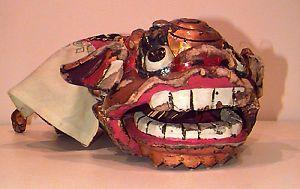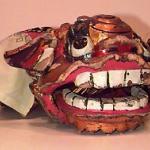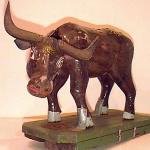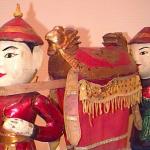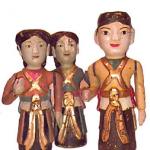Water Puppetry in Vietnam: Better than the Muppets
Puppetry has a long and varied history that spans the globe, but only in Vietnam do puppets slice off each other's heads. Sure, Indonesia has the graceful Javanese shadow puppets and Japan the bunraku theater with black-clad ninja puppeteers. Europe offers the rambunctious Punch and Judy, not to mention fantastic nose-growing marionettes like Pinocchio. And in America Jim Henson created Kermit the Frog, Miss Piggy and all the other members of the madcap Muppet gang. But amphibious Vietnamese water puppets beat all these diverse strands of puppetry. To learn about this 800-year-old art form, which prominently features severed heads, there is no better book than Vietnamese Traditional Water Puppetry.
The Gioi Publishers of Hanoi printed the second edition in 1996. Co-authored by Nguyen Huy Hong and Tran Trung Chinh, this 79-page softcover features numerous full-color photos of water puppetry-known as roi in Vietnamese. The authors cover the emergence of water puppetry guilds, the workings of water-based theater and the evolution of puppet characters and story lines. According to the authors, the goal of the book is to provide readers with insights into the historical development of water puppetry, its roots and roles in traditional Vietnamese society as well as the stories, language and songs featured in this enduring form of folk entertainment. To help western readers understand Vietnam-specific references, the book features excellent footnotes that clarify various points in the text.
Water puppetry has its origins in the Red River Delta of northern Vietnam. Many towns and villages in this area feature communal ponds, and it was in these public spaces that the art of water puppetry first developed in the eleventh century AD. As it evolved over the centuries from folk art to a more established art form, the simple theater stages of wood, bamboo and cloth developed into permanent structures. Due to their solid construction, some of these stages have survived until the present day. Vietnamese Traditional Water Puppetry features photographs and detailed architectural drawings of the two oldest stages still hosting puppetry performances in Vietnam: the Thay Pagoda stage (dating to the Le Dynasty, 1533-1708) and the Dong Temple stage (dating to 1775).
Puppeteers carve their puppets from the ubiquitous fig tree and waterproof them with resin from the lacquer tree. Puppets range in height from 12 to 40 inches (30 to 100 centimeters) and in weight from two to ten pounds (one to five kilograms). During performances, puppeteers control their puppets through a pole-and-string apparatus concealed by the pond water. This apparatus extends behind the stage curtain to the hidden puppeteers who stand in waist-deep water. In this way, explains the book, Vietnamese water puppetry differs from marionettes (control from above) or finger puppets (control from below).
Over time, as with many other kinds of artisans and craftsmen in Vietnam, puppet-makers and puppeteers banded together into guilds. These tended to be named after the members' home community, such as the Rach and Tay Ngoai Guilds. The book provides a complete list of the guilds, and also states that to become a member of such an organization, one must "be decently dressed," which rules out the average western tourist. In addition, one must place rice wine, betel rolls and areca nuts on the altar of the guild's founder. If accepted to the guild, a new member must drink a vermilion concoction that symbolizes human blood and then take an oath to keep the secrets of the guild. Failure to do so "is at the cost of the life of the father and that of three successive offspring."
Vietnamese Traditional Water Puppetry also summarizes the many plots of water puppetry performances. Characters can be heroic, legendary or mythic, but most are ordinary peasant characters living in an age-old village protected by clusters of giant bamboo. Plot lines tend to be action-oriented as it is beyond the ability of the puppets to convey emotional conflicts. A common plot device involves decapitation. For example, in a scene titled "Felling Banana Trees," a luckless character named Lieu Thang loses his head--literally. And in a vignette from the classical drama Son Hau, Khuong Linh Ta's head is severed and drifts away on the lake water. However, the resilient character chases after his own head, picks it up and carries it offstage. Such climactic moments often feature quantities of fireworks, including the fearsome phao rit, which explodes while diving underwater like a foraging duck. Along with the pyrotechnics comes a cacophony of drums, gongs, cymbals and bells, plus assorted enthusiastic noises from the audience.
Without a doubt the best place to watch water puppets lose their heads is during a traditional festival in a northern Vietnamese community with a puppetry guild. However, if you can't rustle up the cash for an air ticket to Hanoi, the book notes that recently Vietnamese puppeteers performed for audiences in France, Germany, Japan and Sweden. They have even moved in on Miss Piggy's home turf and toured cities in the United States.
Vietnamese Water Puppets / History of Water Puppets
The art of water puppetry, or mua roi nuoc, has roots that date back to the tenth century when it originated in the Red River Delta area of northern Vietnam. The farmers in the region celebrated festivals and harvests by performing this unique art form. Over the years, different villages have developed their own personal water puppet plays to mark certain battles or events.
Originally, the puppetry was always performed on a stage built in ponds. Wires were strung between stakes and as many as 200 scenes about village life and legends could be acted out. Today a show usually only incorporates about twenty five scenes. Some of the stages were permanent, but most were temporary wooden or bamboo structures in the shape of a temple which would be put up on special occasions.
The puppets are made of wood and usually stand sixteen inches high, but can be as tall as three feet. The puppet always has two parts: the body which is seen above the water, and the base which is under the water. The head and the arms are usually movable and are sometimes attached with cloth. The strings or wires used to connect the different parts of the puppets body can be made out of many things - even twisted hair covered with a layer of wax. The puppets may take on a lacquered look after being painted many times with a vegetable-based paint.
There are three ways of operating the puppets. Some puppets are attached to a long bamboo pole and dipped in and out of the water by a person behind a rattan curtain. The larger puppets are often attached to a round wooden disc which can serve as a floating attachment to the poles. Some puppets use a combination of both and may have a rudder to help guide them.
Learning to manipulate the puppets is usually a tradition that is passed on as a family secret. It takes a great deal of skill and because the puppeteers hands are underwater it is easy for them to hide their methods. Up to three poles are used with the puppets attached to the middle pole and the other rods supporting the puppet's. The legs don't move. Behind the stage, there is usually a central place to rest the puppets not in motion, and some puppeteers operate more than one figure at a time.
The technique has not changed much since water puppets were first created, although natural ponds have been replaced by nine-feet-long portable water basins. The stage is actually rectangular and is broken up into three areas. The puppets are kept on the floor above the two side rooms and the musicians play from one side.
The fascinating part is that the central room is below the water line, and the puppeteers stand in the waist-deep water. A rattan curtain hides them, but they can see the stage and the audience through the bamboo slats
Water has always played a central role in Vietnamese culture. And the word for water, nuoc, also means country or nation. The puppets advance and retreat in the water with the wave sound always being an important factor. The water must be a little muddy just like the ponds were so that the poles and mechanics can be obscured.
People who have seen water puppet performances often remember the music that goes along with the show. The drum beats more and more quickly as the show is about to begin. There is a drummer and gong and chants and songs to help animate the story, and the percussion instruments accompany the gestures to keep up the rhythm of a performance. The music also often introduces the theme of the play. No performance is complete without firecrackers which add to the excitement.
In the past, the puppeteers were peasants and belonged to a guild. As time went on, permission to enter the guild was more and more selective and the head of the guild, or ong trum, was responsible for many things including finances because the performances were free. Today the puppeteers in the Central Troupe are professionals who receive a monthly salary from the Direction of the Central Troupe of Vietnamese Puppets, a government agency, and they receive special grants when they perform outside the country.
Scenes from the Thang Long Puppet Troupe
Scenes in water puppetry are very short, usually lasting between one and seven minutes. Each recreates a certain activity or aspect of life in a traditional way that is very relevant to the Vietnamese. Human gestures and the actions of animals are readily adapted to water puppetry. The opening stage is a pond of water framed by a golden pagoda. There is a platform to the right for the musicians.
A Typical Program for the Thang Long Puppet Troupe
1. Raising of the Festival Flags to signal the beginning of the show.
2. Chu Teu or the narrator is introduced - he is the master of ceremonies. He is young, underdressed, naïve, irreverent and has a sharp wit and banters with the musicians and the audience.
3. Dance of the Dragons: Four dragons dance on the surface of the water greeting the audiences. Legend has it that the Viet people were descended from the union of a dragon and a fairy. They were powerful, wise and benevolent.
4. Bamboo Flute Player on a Buffalo - a popular folk song asks, "Who said that tending buffaloes is a hard life? Let me tell you about the rice fields, the villages enclosed in emerald green bamboo, the sound of a flute floating above the back of the buffalo". This evokes many shared memories.
5. Farming - The puppets are busy depicting the various activities crucial to agricultural life such as tilling the soil, planting rice and irrigating the fields by bucket. Eighty percent of Vietnamese live in rural areas.
6. Catching Frogs to supplement their diet and to sell in city markets; they are considered a succulent dish.
7. Rearing Ducks and Catching Foxes - in the major deltas of the country rice fields and ponds provide a natural habitat for ducks, but their tenders must be ever vigilant of the sneaking foxes.
8. Fishing - This is an important part of the Vietnamese diet and plentiful because of the long coastline, rivers, ponds and lakes. Both children and adults catch fish with all manner of baskets, nets and rods.
9. The Scholar's Triumphant Return: Exams were held every three years in the capital to select mandarins. Graduates were appointed to all levels of bureaucracy. The graduates then made a triumphant return to their respective native villages with fine clothing, honor guards, trumpets, flags, carriages and offerings.
10. Lion Dance: On the water, the puppets recreate the joyful lion dance which men perform throughout the country for the Summer Festival
11. Phoenix Dance: The courtship of a male and female phoenix is a depiction of the ritual in which the soulmates meet. They symbolize noble love and fidelity.
12. Horse Racing: Two steeds gallop along in a race while two neatly dressed young horsemen watch them attentively from the side. Each of the lads jumps on a horse and spurs it on to greater speed. The two even compete with each other in their skill at jumping on and off horseback.
13. King Le Loa and the Turtle or the Legend of the Restored Sword Lake: Le Loa led a ten-year uprising (1418-1427) to regain independence from China. Le Loi was greatly helped by a magic sword given to him by a turtle. After he became king in 1428, one day when boating on a lake in the capital, a giant turtle surfaced and asked for the sword back and the king then named the lake Hoan Kim (Restored Sword). "The lengthy sword has helped me before, it defeated tens of thousands of invaders. Now in peace, the magic sword is returned to its owner, and this lake shall be remembered as Hoan Kiem."
14. Children playing in water: Water is life sustaining in Vietnam as well as a great place to play.
15. Boat Racing - "Oye! Oye! Oye! The boat races begin and the competition is mighty.
16. Unicorns Play with a Ball: Two unicorns toss a ball back and forth, bringing to mind the rhythmic strengthening exercises of the martial arts.
17. Fairy Dance - King Lac Long Quan married Au Co in 2800 BC and they had 100 sons. After a time he told her "I came from the dragon and your ancestors were the fairies, it would not be possible for us to last forever together. Why don't you take 50 of our sons up to the mountains while I take the other 50 down to the sea? Lac Long Quan established the eldest son as the king of the new realm and the new King named himself Hung Vuong, and began the first Vietnamese dynasty.
18. Dance of Four Magical Animals: The guardians of Vietnamese temples who have the most magical powers (the dragon, the unicorn, the turtle and the phoenix) perform a closing dance.
 ThingsAsian
ThingsAsian